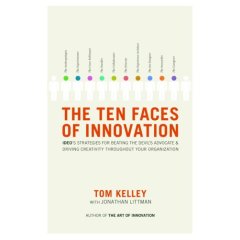Seven Secrets to Brainstorming
 The following is from Tom Kelley's The Ten Faces of Innovation: IDEO's Strategies for Defeating the Devil's Advocate and Driving Creativity Throughout Your Organization
The following is from Tom Kelley's The Ten Faces of Innovation: IDEO's Strategies for Defeating the Devil's Advocate and Driving Creativity Throughout Your Organization1. Sharpen Your Focus.
Begin with a clear statement of the problem, a question that's open-ended but not too broad. Focusing on a specific latent customer need or one step of the customer fourney can often spark a good ideation session. For esample, "How could we gain deeper insights into the experience of our first-time customers?" would be a useful brainstorming topic for many organizations.
2. Mind the Playground Rules
We've stenciled our brainstroming rules high on the walls of many of our conference rooms: Go for Quantity, Encourage Wild Ideas, Be Visual, Defer Judgment, One Conversation at a Time. Even in a rult-averse culture, we've found these basis principles to be both instructive and empowering.
3. Number Your Ideas
Numbering your ideas motivates particpants, sets a pace, and adds a little structure. A hundred ideas per hour is usually a sign of a good, fluid brainstorm, and even if the group is nearly out of steam when you hit number ninety-four, it's human nature to want to pus on for at least half a dozen more.
4. Jump and Build
Even the best brainstroms hit plateaus. You have a flurry of ideas and then they start to get repeitive or peter out. That's when the facilitator may need to suggest switching grears: "How might we apply these ideas to ....?" Push forward with a small variation or cycle back to a promising earlier idea to maintain momentum and build energy.
5. Remember to Use the Space
Leverage the physical environment to make your brainstrom more effective. Let your brainstrom literally take shape and fill the room--write and draw your concepts with the markers on gian Post-its stuck to every verticle surface. Capture your ideas in visual, low-tech mendiums that everyone can share. Spatial memory is a powerful force you can use to guide the participants back on track.
6. Stretch First
Ask attendees to do a little homework on the subject the night before. Play a zippy word game to clear the mind and set aside everyday distractions. Borrowing from the world of imporv. we often start with some form of warm-up, like free association, where I toss out a word or idea and another person quickly builds on it and tosses it to someone else. Athletes stretch. So do brainstormers.
7. Get Physical
At IDEO, we keep foam core, tubing, duct tape, hot-melt glue guns, and other prototyping basics on hand to sketcdh, diagram, and make models. Some of our best brainstorms have quickly leaped to roughing out an idea with a crude prototype.


1 Comments:
Should have read this before that lame CityFocus meeting. That and never to invite guys from DUSK.
Post a Comment
<< Home